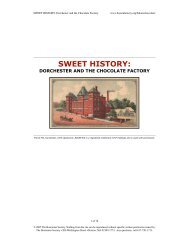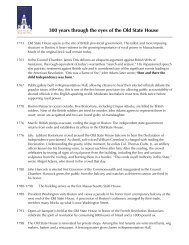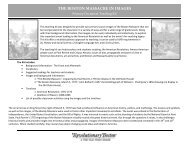Mapping Revolutionary Boston for Educators Lesson Four - Daily ...
Mapping Revolutionary Boston for Educators Lesson Four - Daily ...
Mapping Revolutionary Boston for Educators Lesson Four - Daily ...
You also want an ePaper? Increase the reach of your titles
YUMPU automatically turns print PDFs into web optimized ePapers that Google loves.
2<strong>Daily</strong> Accounts of Colonial Life Teacher Sheet, Page 1Our understanding of any historical event is incomplete. We are not able to hear from everyone whoparticipated in activities long finished, even when their involvement was integral to what transpired.The American Revolution is central to our nation’s history and there are many accounts from avariety of sources. Many of the events are well-known, but the story is incomplete. What of the thousandswho lived and worked, protested and boycotted in the colonies? How did they contribute to the Revolution?Did they all agree with those who sought to sever ties from England? How would this separation benefitthem? What would freedom be <strong>for</strong> them? How do all of these stories, taken together, really become the storyof our nation’s founding?Procedure1. Explore with students how we know about the past. Whose version of events do we have? Are theycomplete?2. In your studies of the American Revolution, emphasize that everyone is the colonies was affected bythe mounting tension, but we know very few of the individual stories. What are possible ways wecan learn about those besides Adams, Washington, and Franklin?3. Provide students with excerpts from the diaries of John Rowe and Anna Green Winslow and havethem complete Student Worksheet I. Discuss their responses.4. Direct students to the <strong>Mapping</strong> <strong>Revolutionary</strong> <strong>Boston</strong> website and assign them one of the followingpeople:Lydia GregoryCuming SistersThomas HutchinsonIsaiah ThomasGeorge Robert Twelves HewesPhillis WheatleyJohn JeffriesMather BylesBenjamin EdesJoseph WarrenJosiah Quincy Jr.John HancockAndrew OliverJohn RoweJames OtisJohn Singleton Copley5. Have them complete Student Worksheet II. They can present their results directly or you maydisplay them in the room. Have a follow up discussion. Be sure to explore what was important totheir historic figures. How did they experience the daily occurrences and the big events of this timein history? How were their stories part of America’s story?Time AllocationSection 1: 20-30 minutesSection 2: Time out of class to learn about their person and write diary entries. One class period to sharediaries.Materials Needed• Excerpts from the diaries of John Rowe, Anna Green Winslow• Access to <strong>Mapping</strong> <strong>Revolutionary</strong> <strong>Boston</strong> WebsiteEnrichment Activities1. Dialogue pairs—have students work in small groups and imagine a dialogue between their twohistoric figures or between one of their figures and a more well-known person from the time.2. Have students imagine other means to learn about someone who did not leave a written account andpresent that ‘evidence’.3. Have students learn more about John Rowe and his diary:http://www.masshist.org/revolution/resources/rowes.phpImagine his entries with those ‘pins’ with whom he would not have had contact: Phillis Wheatley,Lydia Gregory; or specific events: the <strong>Boston</strong> Tea Party or the <strong>Boston</strong> Massacre.






